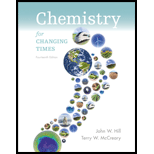
Concept explainers
(a)
Interpretation: LiOH should be identified as a strong acid, a weak acid, a strong base, a weak base, or a salt.
Concept Introduction:
Acid is a substance which produces hydrogen ion/s in the aqueous solution and base is a substance which produces hydroxide ion/s in the aqueous solution. An acid or a base can be classified as strong or weak. Strong acid or base, completely dissociates into their respective ions but weak acid or base partially dissociates into the respective ions in the aqueous solution. A salt is formed by reaction of an acid and a base.
(b)
Interpretation: HBr should be identified as a strong acid, a weak acid, a strong base, a weak base, or a salt.
Concept Introduction:
Acid is a substance which produces hydrogen ion/s in the aqueous solution and base is a substance which produces hydroxide ion/s in the aqueous solution. An acid or a base can be classified as strong or weak. Strong acid or base, completely dissociates into their respective ions but weak acid or base partially dissociates into the respective ions in the aqueous solution. A salt is formed by reaction of an acid and a base.
(c)
Interpretation: HNO2should be identified as a strong acid, a weak acid, a strong base, a weak base, or a salt.
Concept Introduction:
Acid is a substance which produces hydrogen ion/s in the aqueous solution and base is a substance which produces hydroxide ion/s in the aqueous solution. An acid or a base can be classified as strong or weak. Strong acid or base, completely dissociates into their respective ions but weak acid or base partially dissociates into the respective ions in the aqueous solution. A salt is formed by reaction of an acid and a base.
(d)
Interpretation:  should be identified as a strong acid, a weak acid, a strong base, a weak base, or a salt.
should be identified as a strong acid, a weak acid, a strong base, a weak base, or a salt.
Concept Introduction:
Acid is a substance which produces hydrogen ion/s in the aqueous solution and base is a substance which produces hydroxide ion/s in the aqueous solution. An acid or a base can be classified as strong or weak. Strong acid or base, completely dissociates into their respective ions but weak acid or base partially dissociates into the respective ions in the aqueous solution. A salt is formed by reaction of an acid and a base.
Want to see the full answer?
Check out a sample textbook solution
Chapter 7 Solutions
Chemistry For Changing Times (14th Edition)
 ChemistryChemistryISBN:9781305957404Author:Steven S. Zumdahl, Susan A. Zumdahl, Donald J. DeCostePublisher:Cengage Learning
ChemistryChemistryISBN:9781305957404Author:Steven S. Zumdahl, Susan A. Zumdahl, Donald J. DeCostePublisher:Cengage Learning ChemistryChemistryISBN:9781259911156Author:Raymond Chang Dr., Jason Overby ProfessorPublisher:McGraw-Hill Education
ChemistryChemistryISBN:9781259911156Author:Raymond Chang Dr., Jason Overby ProfessorPublisher:McGraw-Hill Education Principles of Instrumental AnalysisChemistryISBN:9781305577213Author:Douglas A. Skoog, F. James Holler, Stanley R. CrouchPublisher:Cengage Learning
Principles of Instrumental AnalysisChemistryISBN:9781305577213Author:Douglas A. Skoog, F. James Holler, Stanley R. CrouchPublisher:Cengage Learning Organic ChemistryChemistryISBN:9780078021558Author:Janice Gorzynski Smith Dr.Publisher:McGraw-Hill Education
Organic ChemistryChemistryISBN:9780078021558Author:Janice Gorzynski Smith Dr.Publisher:McGraw-Hill Education Chemistry: Principles and ReactionsChemistryISBN:9781305079373Author:William L. Masterton, Cecile N. HurleyPublisher:Cengage Learning
Chemistry: Principles and ReactionsChemistryISBN:9781305079373Author:William L. Masterton, Cecile N. HurleyPublisher:Cengage Learning Elementary Principles of Chemical Processes, Bind...ChemistryISBN:9781118431221Author:Richard M. Felder, Ronald W. Rousseau, Lisa G. BullardPublisher:WILEY
Elementary Principles of Chemical Processes, Bind...ChemistryISBN:9781118431221Author:Richard M. Felder, Ronald W. Rousseau, Lisa G. BullardPublisher:WILEY





